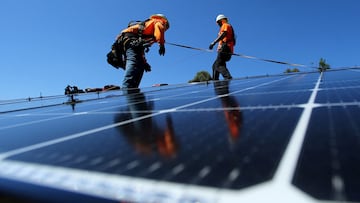Liquid air technology: The solution for storing energy and how the process works
One of the major problems with renewable solar and wind energy is intermittency but a technology that has been around for decades may be the solution.

In order to meet the target set at the COP28 climate summit in Dubai in 2023 of tripling renewable energy capacity by 2030 will require annual growth of 16.6% from 2025-2030 a new report by global renewable groups found. This is despite the capacity around the world to harness renewable energy from the Sun and wind expanding by a record 582 gigawatts, over 15%, in 2024 to 4,443 gigawatts.
The vast majority of that growth came from solar, followed by wind, but they both have one drawback, the Sun isn’t always shining, and the wind doesn’t always blow. In order to truly reduce the need for fossil fuel power sources like coal and gas, which can be turned on and off pretty much with a switch, this intermittency issue must be tackled so that power is available 24/7 to sustain the grid.
Currently, excess energy is being stored by pumping water from one reservoir to another higher up so that it can be sent back through turbines. Another is using grid-scale lithium-ion batteries. However, both have their own limits, geography and length of storage, respectively.
That’s why research into a technology that has been around for decades is getting renewed attention. Liquid air energy storage (LAES) systems could hold the key to storing surplus electricity for when it is needed days later, or even longer. Recent research has found that it could be the lowest-cost option for storing electricity.
How the liquid air energy storage process works
LAES systems are totally clean and could be located just about anywhere according to researchers from the Massachusetts Institute of Technology (MIT) and the Norwegian University of Science and Technology (NTNU). Shaylin Cetegen, a chemical engineer at MIT, explained, “there are no contaminants involved. It takes in and releases only ambient air and electricity, so it’s as clean as the electricity that’s used to run it.”
It involves a three-step process: charging, storing, and discharging. In the first part, air is drawn in from the atmosphere, then cleaned and dried before it is supercooled to the point that it is liquified. Next, it is kept in that state in highly insulated storage tanks, that maintain it at a very low temperature and atmospheric pressure.
Finally, when there is demand for additional electricity on the power grid, it is pumped out, returned to gaseous state, heated and put through turbines at high-pressure, generating electricity before it returns to the atmosphere.
Liquid air energy storage systems recycle heat and cold
Furthermore, to make the system more efficient, excess heat and cold are captured to be used in the different phases of the system. “Without these thermal recovery cycles, the efficiency of the process is closer to 50%, but when we implement this, we can get over 60%, approaching 70% efficiency,” Cetegen told the BBC.
They can also be built near other industries that produce waste heat or cold that they could capture, further increasing a plant’s energy efficiency. Another feature of LAES systems is that they don’t rely on expensive or rare materials, they can be built with components that are largely commercially available.
Liquid air energy storage systems not a pipedream but coming in 2027
The first commercial-scale facility is scheduled to come online in 2027 in Manchester, England. Highview Power, which is building the 300 megawatt-hour storage plant, also has plans to build two more facilities in the United Kingdom.
Related stories
Get your game on! Whether you’re into NFL touchdowns, NBA buzzer-beaters, world-class soccer goals, or MLB home runs, our app has it all.
Dive into live coverage, expert insights, breaking news, exclusive videos, and more – plus, stay updated on the latest in current affairs and entertainment. Download now for all-access coverage, right at your fingertips – anytime, anywhere.

Complete your personal details to comment